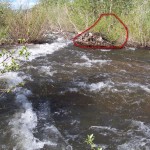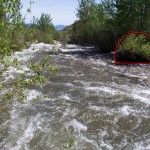
For the last four days, Lee Vining residents and visitors strolling down the Lee Vining Creek Trail could hear boulders knocking against each other over the roar of the whitewater in Lee Vining Creek. The “clunking” sound is coming from the creek—it is the sound of large “bedload” moving—rocks moving along the bottom.
Yesterday Lee Vining Creek peaked at 512 cfs. This is the highest flow in the creek since 1998. Maximizing the peak flow below the DWP diversion dam is the primary tool used to restore the creek from damage done by 40 years of excessive water diversions.


The rapid change in weather from winter to summer during the past week is largely responsible for the high peak flow—we have an April snowpack combined with June weather. Flows increased rapidly late last week and over the weekend, peaking on Monday. High humidity and high winds helped melt the snowpack even faster.
Cooler weather the rest of this week will moderate the snowmelt, but warm weather early next week will cause another peak flow to come down the creek.
Parker, Walker, Alger, and Reversed creeks also experienced a major peak this week. Rush Creek and Mill Creek are largely controlled by dams, but once the reservoirs fill, peaks flows are expected to spill past the dams by early July.
Mono Lake rose a tenth of a foot in the last week thanks to the rapid runoff. See these flows and additional real-time hydrologic data for the Mono Basin here.

Either the photos were not taken from the same spot or zoom level. Notice that the perspective of the center vegetation is not the same at all. What’s going on?
Hi Karen. I don’t believe that Greg intended to duplicate the first photo exactly, but rather to show the sprouting cottonwood log as a reference point to illustrate the volume of water. –Elin
The perspective is very very close. Most of the vegetation on the left is totally gone in the second photo — washed away by the high flow.
The story of high flows on Lee Vining really tells a story of the two river, Lee Vining and Rush. High flows on Lee Vining is restoring the channel and will trigger riparian recruitment, while the dams hold back the high flows on Rush until July which will potentially remove any new recruitment which may have occurred in June. Some day we will learn how to manage all of our rivers.
I am so thrilled to read about the peak flow on the Lee Vining Creek. I wish I were there to see it. All the creeks coming into Mono Lake must be flowing at high volumes. This good news of course, means the Lake is rising. Oh Happy Day.
Duncan is correct–this year is an excellent example of what is right with Lee Vining Creek and what is wrong with the water management on Rush Creek. Luckily, the weather was so cold this year through May that it also delayed the riparian tree seeding. While some willows are starting to seed now, I see no catkins or seed pods on the cottonwoods, which means the peak flow on Rush Creek during the next two weeks isn’t going to be detrimental for seedling recruitment. But the lack of a large enough outlet for Grant Lake Reservoir does mean another mediocre year for channel-forming flows below the dam.